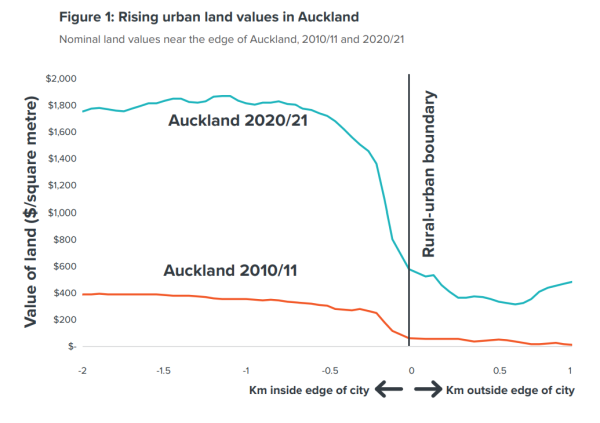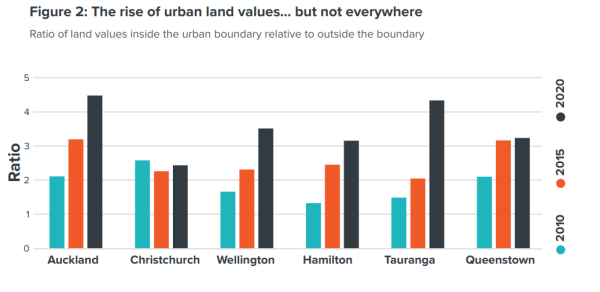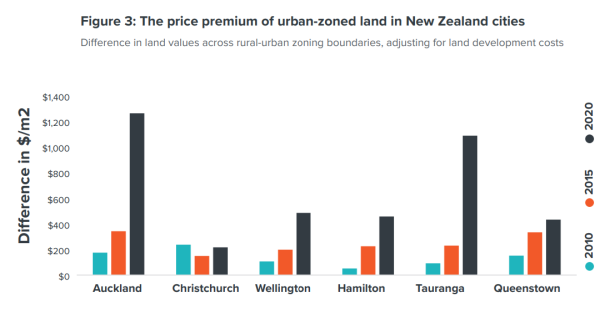Australian cities just became a lot more attractive for younger Kiwis. New Zealand’s housing will have to become a lot more affordable, in a hurry, to avoid losing them.
The Infrastructure Commission’s latest report shows that urban boundaries add over six hundred thousand dollars to the cost of sections at Auckland’s fringes – and about a quarter million in Wellington.
Those effects at cities’ fringes work their way even into the price of downtown apartments, pushing up housing costs across entire cities. And with Australia becoming more open, those effects will also push more Kiwis across the ditch.
Until last week, Australia was a bit risky for Kiwis. Housing there is cheaper relative to wages. But if anything went wrong, Kiwis were excluded from the social welfare services that their Australian taxes funded.
The clear path to citizenship announced last week changes the calculus. The change is obviously for the good. But it also means that policy in New Zealand has to get better, and faster, so more Kiwis will want to stay here.
Just consider the numbers.
Standard measures compare house prices to household incomes to get a measure of affordability. By these median multiple measures, every major urban market in Australia other than Sydney has more affordable housing than Auckland.
The median house in Auckland, in 2022, cost 10.8 times the median household income – according to the latest Demographia report. The median multiple in Melbourne was 9.9; in Adelaide, 8.2; in Brisbane, 7.4; and, in Perth, 5.4.
Our smaller centres have maintained something closer to affordability but have a hard time competing with the opportunities in bigger cities.
Suppose you wanted to improve housing affordability by focusing on the household income side of the median multiple rather than housing costs.
Boosting household incomes requires improving long term productivity growth. It is tremendously important. But it will not do as much as it should to improve housing affordability unless housing policy improves.
When cities cannot grow up and out, higher incomes mainly push up the price of existing homes and of land zoned for more housing. You can imagine it as a terrible game of musical chairs. If you have ten potential homes and eleven families needing a place to live, which does more good: doubling each family’s income, or allowing a couple more homes to be built?
Over the past decade, it has become a lot easier to build new apartments and townhouses. From 2016, Auckland’s Unitary Plan enabled more density. The 2020 National Policy Statement on Urban Development requires cities to allow more housing in places with good access to existing services. And the 2021 minimum residential density standards make it easier to add housing to existing lots.
It has become a lot easier for cities to build up.
But building out has not eased. And the Infrastructure Commission’s latest report puts some numbers on the consequences.
The Infrastructure Commission commissioned work looking at the cost of bare land on either side of New Zealand cities’ rural-urban boundaries.
To make land costs comparable on either side of the boundary, they added in the cost of converting land from rural to urban use: earthworks, surveying and planning, and development contributions toward council infrastructure.
Land inside Auckland’s urban boundary is valued at almost $1,300 more per square metre than land just outside the boundary, after accounting for land conversion costs. Or over $600,000 for a 500 square metre section.
The price premium for zoned land at the city’s fringes more than doubled between 2010 and 2020.

Rural land is measured in hectares rather than sections. A hectare of rural land, at Auckland’s border, would jump in value by $12.7 million if it could be turned into houses. Or, to look at it the other way, a hectare of land just inside the boundary costs $12.7 million more than it should.
Or if you still think in imperial units, the right to build housing on urban land adds over $5 million per acre just inside Auckland’s boundary.
The problem is hardly confined to Auckland, though it is worst there. Tauranga, Wellington, Queenstown and Hamilton all show substantial premiums for land zoned for urban use, after accounting for the cost of developing sections. In all cases, those premiums are higher than they were a decade ago.


The problem will not be confined to city fringes.
Urban land is typically most expensive downtown, where commutes are short and amenities are close at hand. Land prices ease as you move farther away. This urban land price gradient emerges as people decide how much they’re willing to pay to avoid commutes and as developers turn houses and townhouses in desirable places into apartments.
Sections at the fringes of the city then provide competitive pressure that maintain affordability across the city more broadly. If you’re prepared to pay an extra half a million dollars for a home with a short commute and close access to restaurants and theatres, as compared to a house at the edge of town, downtown prices will depend on whether houses at the edge of town cost $250,000 or $750,000.
The cost of a paddock, plus the cost of putting it into urban service, provides an anchor for land prices across the entire city – if it is legal to turn paddocks into houses.
Restrictions on building at city fringes then don’t just make new subdivisions a lot more expensive. Work by Treasury economist Chris Parker suggests they also make apartments and townhouses less affordable by making urban land far too costly across the entire city.
When city land prices are not anchored by the cost of turning paddocks into housing, everything gets out of whack. And when it suddenly becomes a lot less risky to take advantage of more affordable housing in Australia, leaving becomes a lot more tempting.
The Infrastructure Commission points to measures that would make it easier to service sections at city fringes and potentially unlock more land for housing. That work will be important. But it may take more than that.
Central government has laudably directed councils to enable more housing within cities. It may need to do the same to ease zoning at rural-urban boundaries. If new subdivisions here can’t compete for young Kiwi families, Australia’s cities will be the winners.



